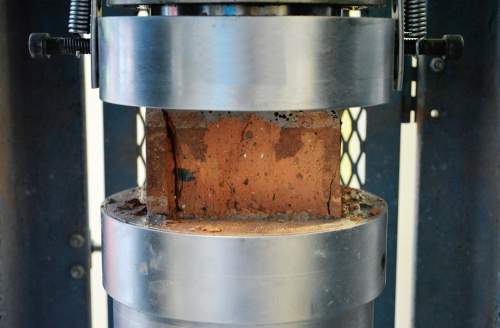Bricks are mainly used in the construction of wall, floor, cornices, and arches. Brick chips are also used as a substitute for stone chips in the concrete mix where a stone is not available or an economic solution is preferred. In all the above-mentioned cases, compression load governs. Due to this, the compressive strength of bricks is a very important parameter.
Specified Compressive Strength
According to BDS 2002
| Grade | Mean Strength (kg/cm2 ) | Minimum Strength (kg/cm2 ) |
|---|---|---|
| S | 280 | 245 |
| A | 175 | 154 |
| B | 140 | 105 |
According to Indian Standard (IS 1077:1992)
| Classification | Average Strength (N/mm2) | Average Strength (kg/cm2) |
|---|---|---|
| 35 | 35 | 350 |
| 30 | 30 | 300 |
| 25 | 25 | 250 |
| 20 | 20 | 200 |
| 17.5 | 17.5 | 175 |
| 15 | 15 | 150 |
| 12.5 | 12.5 | 125 |
| 10 | 10 | 100 |
| 7.5 | 7.5 | 75 |
| 5 | 5 | 50 |
| 3.5 | 3.5 | 35 |
Compressive Strength Test of Bricks
The determination of Compressive Strength Test of Brick is carried out under the specification of ASTM C67-03.
Sampling of Brick
- Selection of Test Specimen: Full-size representative bricks should be sampled randomly to cover the whole range color, texture, and sizes from a shipment.
- Numbers of Test Specimen: At least 10 bricks should be chosen from each lot of 1000000 bricks or fraction thereof. For larger lots, five individual bricks should be chosen from each lot of 500000 bricks or fraction thereof.
Each sample must be marked for identification purposes. Markings must not cover more than 5% of the superficial area of the sample.
Weight determination
Drying
The test specimens should be dried in a ventilated oven at 230oF to 239oF (110oC to 115oC) for at least 24 hours and until two successive weighting at intervals of 2 hours shows an increment of loss not greater than 0.2% of the last previously determined weight of the specimen.
Cooling
After drying, the specimens need to be cooled in a drying room. The temperature must be kept 75+15o F (24+8oC), with a relative humidity between 30 and 70%.
Materials Used
- Cement: Quick hardening cement
- Sand: Locally available good quality sand
- Capping Material: Capping is usually done either using gypsum or Sulphur clay mixture. For the later, a mixture containing 40 to 60 weight % Sulphur, the remainder being fire clay or other suitable inert material passing a No.100 sieve with or without plasticizer is used.
Apparatus
- Capping Mold: Four 1 inch (25.4 mm) square steel bars on the surface plate to form a rectangular mold approximately ½ inch (12.7 mm) greater in either inside dimension than the brick specimen used.
- Testing Machine
Test Procedure
Preparation of the Sample
Dry half bricks with full height and width of the unit and length equal to one half of the full length of the unit + 1 inch (25.4 mm). Ends should be plane and parallel.
{adselite}
Capping the Specimen
- If the surface which will become the bearing surfaces during the compression test is recessed or paneled, the depressions have to be filled with a mortar composed of 1 part by weight of quick-hardening cement and 2 parts by weight of sand. The specimens are to be aged at 48 hours before capping them. Where the recess exceeds ½ inch (12.7 mm), a brick or tile slab section or metal plate is used as a core fill.
- The capping mold is to be placed.
- The Sulphur mixture is to be heated in a thermostatically controlled heating pot to a temperature sufficient to maintain fluidity for a reasonable period of time after contact with the surface being capped. Care is required to prevent overheating and the liquid is to be stirred before using.
- The mold should be filled to a depth of ¼ inch with molten Sulphur material. The surface is to be placed in the liquid vertically.
- The unit must remain undisturbed for minimum 2 hours until solidification.
Testing the Specimen
- Brick specimens are to be tested flatwise. The specimen is to be centered under the spherical upper bearing within 1/16 inch.

Figure: Compressive Strength Test of Brick - The load should be applied up to one half of the expected maximum load, at any convenient rate. Then the remaining load has to be applied at a uniform rate in 1-2 minutes.
Calculation:
Compressive Strength, C= (W/A)
Where,
W= Calibrated maximum load
A= Average of the gross areas of the upper and lower bearing surfaces of the specimen.
Brick Related Articles
- What is brick?
- Types of Bricks
- Composition of Bricks
- Characteristics of Good Bricks.
- Uses of brick.
- Compressive Strength of Brick
- Density of Brick
- Thermal Conductivity of Brick
- Advantages and Disadvantages of Hoffmann kiln.
- What is Refractory or Fire Bricks? Types, Composition
- Properties of Good Refractory Bricks
- Uses of Refractory Bricks
- Lime Pitting

